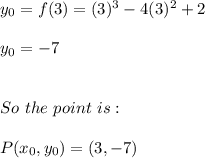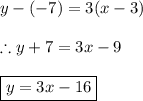
Mathematics, 16.11.2019 22:31 onepunchman20
Consider the function f(x) = x3 − 4x2 + 2. calculate the limit of the difference quotient at x0 = 3 for f(x).
f'(x) = 3x² - 8x
f'(3) = 3(3²) - 8(3) = 3
3
real question:
part a: find the equation of a line passing through the same point that f(x) passes through at x = 3 with a slope equal to the limit you found in part a.
part b: graph the function f(x) and the line you identified in part b. how do the graphs relate to each other? what does the slope of the line represent about the function at the given point?

Answers: 3


Another question on Mathematics

Mathematics, 21.06.2019 17:00
Acircular garden with radius of 8 feet is surrounded by a circular path with a width of 3 feet. what is the approximate area of the path alone? use 3.14 for π
Answers: 3

Mathematics, 21.06.2019 23:00
The ratio of the perimeters of two similar triangles is 4: 3. what are the areas of these triangles if the sum of their areas is 130cm2?
Answers: 3

Mathematics, 22.06.2019 01:20
Aprobability experiment is conducted in which the sample space of the experiment is s={7,8,9,10,11,12,13,14,15,16,17,18}, event f={7,8,9,10,11,12}, and event g={11,12,13,14}. assume that each outcome is equally likely. list the outcomes in f or g. find p(f or g) by counting the number of outcomes in f or g. determine p(f or g) using the general addition rule.
Answers: 2

You know the right answer?
Consider the function f(x) = x3 − 4x2 + 2. calculate the limit of the difference quotient at x0 = 3...
Questions


Mathematics, 14.09.2019 03:30




Computers and Technology, 14.09.2019 03:30













Mathematics, 14.09.2019 03:30







 , so we need to find
, so we need to find  . Plug in that x-value in the function we have:
. Plug in that x-value in the function we have:


 is continuous. This is so because we have plotted a polynomial function whose domain is the set of all real numbers. So the function is defined at the point
is continuous. This is so because we have plotted a polynomial function whose domain is the set of all real numbers. So the function is defined at the point  , so the derivative exists at this point, hence we can calculate a tangent line there. In conclusion, we get the graph shown below. The blue line is the tangent line while the red curve is the graph of
, so the derivative exists at this point, hence we can calculate a tangent line there. In conclusion, we get the graph shown below. The blue line is the tangent line while the red curve is the graph of 


